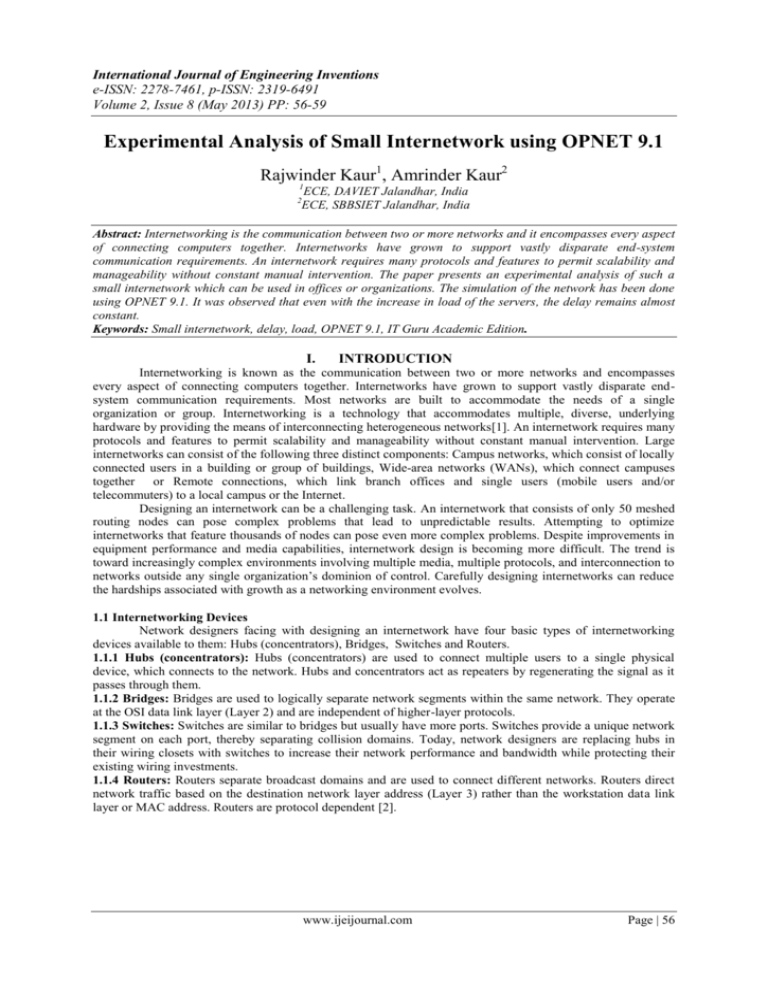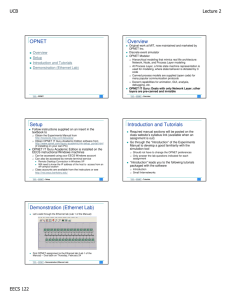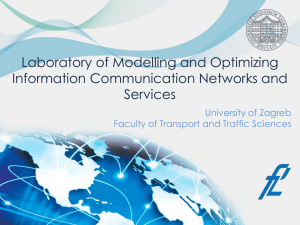Experimental Analysis of Small Internetwork using OPNET 9.1
advertisement

International Journal of Engineering Inventions e-ISSN: 2278-7461, p-ISSN: 2319-6491 Volume 2, Issue 8 (May 2013) PP: 56-59 Experimental Analysis of Small Internetwork using OPNET 9.1 Rajwinder Kaur1, Amrinder Kaur2 1 ECE, DAVIET Jalandhar, India ECE, SBBSIET Jalandhar, India 2 Abstract: Internetworking is the communication between two or more networks and it encompasses every aspect of connecting computers together. Internetworks have grown to support vastly disparate end-system communication requirements. An internetwork requires many protocols and features to permit scalability and manageability without constant manual intervention. The paper presents an experimental analysis of such a small internetwork which can be used in offices or organizations. The simulation of the network has been done using OPNET 9.1. It was observed that even with the increase in load of the servers, the delay remains almost constant. Keywords: Small internetwork, delay, load, OPNET 9.1, IT Guru Academic Edition. I. INTRODUCTION Internetworking is known as the communication between two or more networks and encompasses every aspect of connecting computers together. Internetworks have grown to support vastly disparate endsystem communication requirements. Most networks are built to accommodate the needs of a single organization or group. Internetworking is a technology that accommodates multiple, diverse, underlying hardware by providing the means of interconnecting heterogeneous networks[1]. An internetwork requires many protocols and features to permit scalability and manageability without constant manual intervention. Large internetworks can consist of the following three distinct components: Campus networks, which consist of locally connected users in a building or group of buildings, Wide-area networks (WANs), which connect campuses together or Remote connections, which link branch offices and single users (mobile users and/or telecommuters) to a local campus or the Internet. Designing an internetwork can be a challenging task. An internetwork that consists of only 50 meshed routing nodes can pose complex problems that lead to unpredictable results. Attempting to optimize internetworks that feature thousands of nodes can pose even more complex problems. Despite improvements in equipment performance and media capabilities, internetwork design is becoming more difficult. The trend is toward increasingly complex environments involving multiple media, multiple protocols, and interconnection to networks outside any single organization’s dominion of control. Carefully designing internetworks can reduce the hardships associated with growth as a networking environment evolves. 1.1 Internetworking Devices Network designers facing with designing an internetwork have four basic types of internetworking devices available to them: Hubs (concentrators), Bridges, Switches and Routers. 1.1.1 Hubs (concentrators): Hubs (concentrators) are used to connect multiple users to a single physical device, which connects to the network. Hubs and concentrators act as repeaters by regenerating the signal as it passes through them. 1.1.2 Bridges: Bridges are used to logically separate network segments within the same network. They operate at the OSI data link layer (Layer 2) and are independent of higher-layer protocols. 1.1.3 Switches: Switches are similar to bridges but usually have more ports. Switches provide a unique network segment on each port, thereby separating collision domains. Today, network designers are replacing hubs in their wiring closets with switches to increase their network performance and bandwidth while protecting their existing wiring investments. 1.1.4 Routers: Routers separate broadcast domains and are used to connect different networks. Routers direct network traffic based on the destination network layer address (Layer 3) rather than the workstation data link layer or MAC address. Routers are protocol dependent [2]. www.ijeijournal.com Page | 56 Experimental Analysis of Small Internetwork using OPNET 9.1 II. Results and Tables Table 1: Simulation Environment [3] Value to enter Create empty scenario Select: Office and Check the Use Metric Units box Specify Size Leave the default size: 100 m x 100 m Select Technologies Scroll down and include: Sm_Int_Model_List model family Review Make sure values are correct and click ok Center Node Model 3C_SSII_1100_3300_4s_ae52_e48_ge3 Periphery Node Model Sm_Int_wkstn Link Model 10BaseT No. of nodes used with extension of ethernet 10,15,20,25,30 Name of Dialog Box Initial Topology Choose Network Scale TABLE 1 shows the simulation parameters used to create a small internetwork. Initially an empty scenario is generated with network scale matrix. After the matrix appears the size is specified (eg.100m X 100m). Then following the size, topology to be used is selected after which the central and their peripheral nodes are specified. The Link Model is 10BaseT. In the above scenerio the number of nodes used for analysis vary from 10 to 30 to get the results which show the variation of delay with increasing load with respect to time. The snapshot of the discussion without and with extention of nodes is shown in Fig.1 and Fig.2. Figure 1: Snapshot of network design in OPNET Simulator without extension. Figure 2: Snapshot of small internetwork with extention of network using Ethernet with 10 nodes www.ijeijournal.com Page | 57 Experimental Analysis of Small Internetwork using OPNET 9.1 2.1 Results and discussion: 2.1.1 Load Discussion: Fig.3 shown below shows the result of load of small internetwork with 20 nodes connected to the server. The graph shows that the load varies with respect to time. Fig.3 shows the load value of 4000 with respect to time in seconds. Figure 3: Snapshot of server load with 20 nodes Figure 4: Server load with extension of 10 work stations, duration 1 hours and 8 hour. Fig.4 shows that the load of 10 workstations on server increases with respect to time which is 8 hours. 2.1.2 Delay Discussion: Figure 5: Ethernet delay with respect to time with 25 workstations. www.ijeijournal.com Page | 58 Experimental Analysis of Small Internetwork using OPNET 9.1 The Fig. 5 shows the delay versus time graph. The delay graph shows no change as a result of the additional workstations. This is an expected result considering that the bandwidth of all the Ethernet links is 10BaseT, meaning that 10 Mbps is available for access to the server. Extension in load(workstation) 0 10 15 20 25 Duration Table 2. Final Result Servers Load (bits/sec) 1 5 8 1 5 8 1 5 8 1 5 8 1 5 8 0-2800 1500-2800 1700-2800 1900-5000 1600-3600 2200-3800 0-7000 2000-4500 2600-4050 0-5400 2100-4950 2000-3000 0-7100 1750-2750 2800-5500 III. Delay(sec) .0003 .0004 .0004 .0004 .0004 Conclusion In conclusion, the addition of more workstations as a result of the expansion activities clearly increased the load on the link to the Application Server; however the overall capacity on the10BaseT link was more than sufficient to support the increased number of users trying to access the server. TABLE 2 above shows the result of load and delay by extending the network and without extending the network. It shows that load is exceeded when we increase the no. of nodes on the application server. REFERENCES [1] [2] [3] Ranjan Kaparti ,Professor Dan Likarish , OPNET IT GURU: A Tool for Networking Education, MSCIT Practicum Paper, Regis University. Terri Quinn-Andry and Kitty Haller, Cisco CCIE Fundamentals: Network Design, ISBN: 1-57870-030-2. James D. Boggs, A Tutorial on Basic use of OPNET IT Guru, Academic Edition, 2009. www.ijeijournal.com Page | 59









